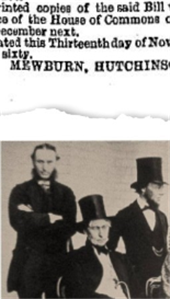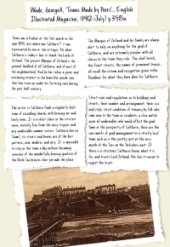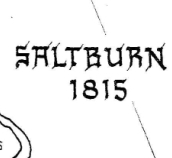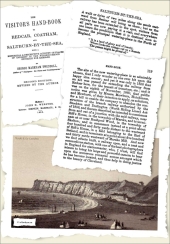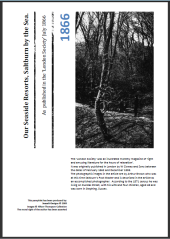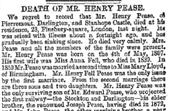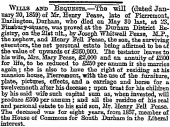Discovering Saltburn's rich heritage ... a Victorian dream.
Henry Pease, the founder of the town of Saltburn by the Sea
The resort of Saltburn by the Sea was founded by the Victorian entrepreneur Henry Pease apparently after having seen a vision. The legacy of this vision is the Station complex, Zetland Hotel, Pier, Cliff Lift and Valley Gardens as well as the so called "jewel streets" along the sea front - Amber, Pearl, Diamond, Emerald, Ruby, Coral and Garnet. Another mark of the founding family is the "Pease brick" set into many of the homes in Saltburn with the name Pease set into the very bricks of the houses. Members of this family founded the Stockton and Darlington railway and the town of Middlesbrough nearby.
The founding of Saltburn by the Sea
Before 1860 only old Saltburn existed, situated next to The Ship Inn, nestling below the cliffs. The fields surrounding Rifts House Farm, the area where Saltburn by the Sea was eventually to be developed, grew oats, beans, turnips, clover or lay fallow. The discovery and exploitation of iron ore in the mid 1800's was to make the most dramatic change in the fortunes of the Saltburn area.
In the industrial history of the 19th century the Pease family held a foremost position. For several generations in succession the name of Pease retained great pre-eminence in the industrial world of the North. Great commercial ability combined with a strong gift of foresight and an indomitable enterprise characterised both Edward Pease and his immediate descendants.
The family held several firms. These included the firm of Joseph Pease & Partners, coal-owners. J. W. Pease & Co. dealt in ironstone and limestone. The banking business was carried on under the style of J & J. W. Pease. The extensive woollen mills were carried on under the name of Henry Pease & Co. The head-quarters of all these firms was in Northgate, Darlington.
Their two most important undertakings were the coal mines in South Durham and the ironstone mines in Cleveland. In the development of the Cleveland ironstone industry they took a leading part and the first royalty taken in their name was dated in March 1852, from which time they stood at the forefront of Cleveland mine owners. The first mine which they opened was at Hutton, near Guisborough. Its total output in 1853, its first working year, was 6646 tons. In 1857, when the Hutton Mine was at its best, they acquired the Upleatham mines, said to be the largest in the kingdom, from the Derwent Iron Company. The neighbouring Hob Hill mine was opened by them in 1864. Their most extensive mine workings after Upleatham were at Skinningrove.
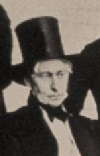 Henry Pease, the youngest son of Edward Pease, began his apprenticeship in a family tanning establishment in Darlington.In 1881, at the time of his death, there were still three woollen mills in Darlington belonging to the firm of Henry Pease & Co. In an article published in the 'London Society' in November 1881 Henry was described as having been 'a man of such energy of character' that he was 'not likely to escape being caught by the railway fever which raged around him' and 'no sooner had he attained his majority than he ... entered heart and soul into the work of railway promotion.'
Henry Pease, the youngest son of Edward Pease, began his apprenticeship in a family tanning establishment in Darlington.In 1881, at the time of his death, there were still three woollen mills in Darlington belonging to the firm of Henry Pease & Co. In an article published in the 'London Society' in November 1881 Henry was described as having been 'a man of such energy of character' that he was 'not likely to escape being caught by the railway fever which raged around him' and 'no sooner had he attained his majority than he ... entered heart and soul into the work of railway promotion.'
Henry Pease's name came to be connected with nearly all the lines of importance that were projected in the North of England, some of which were originated by him. From 1830-35 he was mentioned in the minute books of the S & D railway as a troubleshooter, resolving technical difficulties. For over forty years he was unremitting in his attendance in the board room of one railway company or another, his latter years being engaged principally on behalf of the North Eastern Railway Company. It is, therefore, possible to state that perhaps no man of his time had a longer or more distinguished career as a railway director.
Henry was associated with his brother, Joseph, in the founding of the Middlesbrough & Guisborough line and was the first chairman of that line. He also played an active role in the establishment of a line between Darlington and Barnard Castle and subsequently the South Durham and Lancashire Union Railway. After the establishment of the latter several amalgamations were effected - at the suggestion of Henry Pease. The South Durham and Lancashire was amalgamated with the Stockton & Darlington which, together with its tributary lines, was itself absorbed into the North Eastern system.
His wider influence was felt in a number of directions. As well as being a board member of Pease & Partners in their many enterprises, eventually becoming a senior partner of the firm, he also became an MP for South Durham between 1859 to 1865 and took an active part in the Sunday Closing Bill. He owned the building firm that erected the Darlington Iron Co. and owned the brickworks that provided the white firebricks used extensively on the first buildings erected in Saltburn by the Sea. He was chairman of the Stockton & Middlesbrough Water Company and the Weardale & Shildon Water Co. He also became the first Mayor of Darlington.
Henry Pease, like his father, was also a member of the Quaker Society of Friends and of the Peace Society. As a Quaker he travelled to Russia in an attempt to stem the outbreak of war with England in 1853. As a member of the Peace Society he visited the French Emperor, Napoleon III, in 1867. Henry also visited America for three months in 1856.
Mary Pease, writing in retrospect of her husbands life, says that in 1859 Henry Pease was staying with his brother at Marske. One evening he returned late for dinner. He explained that he had walked to Saltburn and that "seated on the hillside he had seen, in a sort of prophetic vision, on the edge of the cliff before him, a town arise and the quiet unfrequented glen turned into a lovely garden." Other sources further claim that he persuaded the S & D Railway to extend their lines in order to allow him to build his visionary town. However, the railway extension to Saltburn had already received the Royal assent in the North Riding Railway Act of 23rd July 1858. Tweddell, writing in 1863, also states that the line was specifically granted 'for the transit of ironstone'. Tweddel then remarks that by 1860 the company had applied for a bill to enable them to abandon their original intention - which was that the branch was to commence from and out of a junction near Rifts House and to terminate at or near Rushpool Wood - in favour of a spot four hundred and forty yards westward of Rifts House, in a field belonging to the Earl of Zetland.
Having already opened the railway to serve the Upleatham mine, the Peases were looking at the prospects offered by the discovery of ironstone in East Cleveland. Any railway built to serve the area would be expensive to build and it is much more likely that Henry was looking for something which would defray the costs should the East Cleveland deposits prove not to be as rich as expected. Henry's visit to America had also shown him the effect of the railway in the development of towns and he hoped that the same would happen in England. As Teesside industrialisation mushroomed there were numerous people of considerable wealth who were drawn to the area who would also be in need of summer facilities for their families. Thus Henry gambled on establishing a select area to cater for the wealthy with two or three high class hotels and a number of villas for the wealthy. Henry also reasoned that should the lower paid new workers of the ironstone industry be able to afford holidays, then Saltburn could also be tailored to suit them. As excursion trains were excluded from the 5% duty levied on railfares by the 1844 Bill, Henry also reasoned that it would be possible to offer cheap excursions to his new town and the S & D railway income would not suffer.
The decision on developing Saltburn met with opposition from the S & D board - Mr George Morley of Guisborough stating that he thought it was 'a very bad speculation' for having lived in the area he thought it 'a nasty bleak cold place, and the sand is horrid'. Opposition was also encountered from others who felt that Lord Zetland should promote the development of Redcar and Marske rather than Saltburn.
Whatever objections were raised, plans went ahead and, having secured the support of the railway company, Henry Pease formed the Saltburn Improvement Company in 1859. As Lord Zetland owned the land on the clifftop the SIC approached him in 1860 offering to buy 10 acres of Penn Pasture, which formed part of Rifts Farm whose farmhouse stood where the west side of Hilda Place is now. It was to be the first of 11 lots the company would buy over the next 16 years totalling nearly 135 acres.
Whilst the offer of £120 per acre was being considered Henry Pease and Thomas McNay visited Scarborough, ostensibly to inspect the towns sewage disposal system. During this visit Henry's attention was engaged by the pleasure grounds which were being developed there and thus began his own personal passion for the development of similar grounds at Saltburn.
George Dickinson of Darlington was employed to lay out a plan of the town. The buildings had to have uniform roof lines, slate roofs, frontages of white firebricks (from the Pease's own brickworks) and no fences.
Within 20 years the main form of the town had been created including the Station Complex 1862; Valley Garden's 1861/62; Zetland Hotel 1863 (reputed to be one of the world's first purpose built railway hotels to have its own private platform), Wesleyan Chapel 1863, Pier 1869 and Cliff Hoist 1870. With the death of Henry Pease in 1881 the town's driving force was lost and soon after the Saltburn Improvement Company was disbanded.
Over the years no substantial new features were added to the resort and it became encapsulated in time as one of the finest early Victorian seaside towns surviving almost completely in its original form.
Research by Rebecca Hilton. Collecting primary source materials, articles and extracts from books related to the development of both Saltburn's and trying to validate them has offered conflicting information, much of which is often difficult to validate as many sources can prove to be unreliable e.g. newspapers or census data. Every effort has been made to ensure that the information on the history of the town presented here is as accurate as possible.


